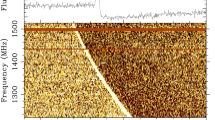Abstract
This list is based on 20 stars in the solar neighborhood for which there are 52 spectra. Twelve of them are known as UV Ceti flare stars. The others behave like flare stars, but are not known to be such. Among the 20 there are many binary and triple flare stars. They all belong to the disk population of the Galaxy. Red dwarfs comprise one of the numerous populations of the system. Flare stars either continue to flare or have ceased flare activity. Three diagrams are given that show satisfactory agreement with the expected ones. A cluster analysis is carried out, which is in agreement with the original proposition and confirms the foregoing.
Similar content being viewed by others
Literature Cited
G. H. Herbig, in:Symposium on Stellar Evolution, J. Sahade, ed., Astron. Obs. Nat. Univ. La Plata (1962), p.45.
W. Gliese,Catalogue of Nearby Stars, Veroeff. Astron. Rechen-Institute, Heidelberg, No. 22 (1969).
L. V. Mirzoyan,Astrofizika,36, 277 (1993).
R. E. Gershberg,Low-Mass Flare Stars [in Russian], Nauka, Moscow (1978); see N. L. Shakhovskaya,UV Ceti Stars in the Solar Neighborhood.
T. Yu. Magakian and S. V. Zaratsian,Soobshch. Byurakan. Obs.,55, 80 (1984).
J. R. Stauffer,Astron. J.,85, 1341 (1980).
J. R. Stauffer and L. W. Hartmann,Astrophys. J. Suppl. Ser.,61, 531 (1986).
B. R. Pettersen and S. L. Hawley,Astron. Astrophys.,217, 187 (1989).
D. S. Evans, in: Proceedings of a Byurakan Symposium, L. V. Mirzoyan, ed.
M. Rodono,Flare Activity in Binary Systems, Catania Obs. Preprint (1979).
R. Wooley, S. B. Pocock, E. A. Epps, and R. Flinn,R. Obs. Bull., No. 166 (1971).
L. V. Mirzoyan, V. V. Hambaryan, and A. T. Garibjanian,Astrofizika,33, 5 (1990).
L. V. Mirzoyan, V. V. Hambaryan, A. T. Garibjanian, and A. L. Mirzoyan,Astrofizika,31, 259 (1989).
G. H. Herbig, in:Problems of the Physics and Evolution of the Universe, L. V. Mirzoyan, ed., Acad. Sci. Armenian SSR, Yerevan (1978), p. 171.
V. A. Ambartsumian and L. V. Mirzoyan, in:New Directions and New Frontiers in Variable Star Research, IAU Colloq. No. 15,Veroeff. Bamberg,9, No. 100, 98 (1971).
Author information
Authors and Affiliations
Additional information
Translated from Astrofizika, Vol. 40, No. 2, pp. 187–196, April– June, 1997
Rights and permissions
About this article
Cite this article
Mirzoyan, L.V., Hambarian, V.V. & Garibjanian, A.T. Spectroscopic observations of red dwarfs. III. Observations of red stars in the solar neighborhood. Astrophysics 40, 125–130 (1997). https://doi.org/10.1007/BF03036105
Received:
Issue Date:
DOI: https://doi.org/10.1007/BF03036105




